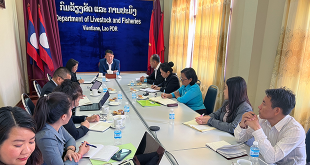by Mr. Kong Kham Vonglokham
2017 Regional Fisheries Policy Network (RFPN) Member for Lao PDR
INTRODUCTION
Lao PDR is a mountainous land-locked country in the heart of Southeast Asia with an area of 236,800 km2. The country is bordered by five countries: China and Myanmar in the north, Cambodia in the south, Viet Nam in the east, and Thailand in the west (Figure 1). The capital is Vientiane and the country is divided into 18 provinces, subdivided into 148 districts and 8,507 villages, and consists of 49 different ethnic groups.
| Figure 1. Map of Lao PDR Source: FAOSTAT, 2018 |
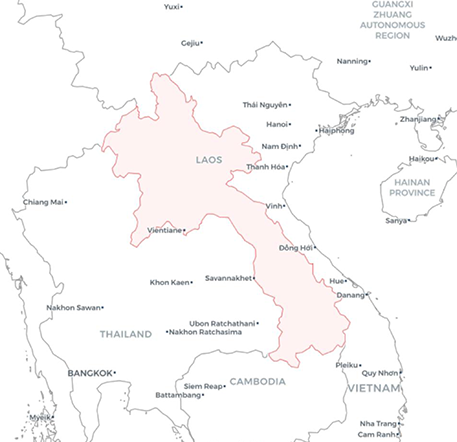 |
In the waters of Lao PDR, there are native fish fauna that comprise 47 families out of the 91 recorded in the 2003 Mekong Fish Database or more than 50 per cent of those recorded in the whole Lower Mekong Basin (LMB) as reported by Coates et al. (2003). More than 481 fish species have been identified, of which 22 species are considered as exotic species. About 37 species of amphibians, 7 species of crabs, and 10 species of shrimps have been recorded but these records cover only about 15% of the total. Species cataloguing has yet to be completed in Lao PDR as well as in the LMB, and further taxonomic studies are especially required in the upper reaches of the country’s tributaries.
The total population of Lao PDR was 6.5 million in 2015, of which 80% still live in rural areas and depend on the country’s fish and other aquatic animals as their most reliable sources of animal protein. The country’s estimated average fish consumption of inland fish is 24.5 kg/capita/year, while other aquatic animals account for about 4.1 kg/capita/year, and marine products around 0.4 kg/capita/ year, making a total of 29.0 kg/capita/year of fish and aquatic products consumed (Hortle, 2007).
Capture fisheries and aquaculture in Lao PDR are based on its water resource ecosystems which consist mainly of rivers and streams, hydropower and irrigation reservoirs, diversion weirs, small water bodies, flood plains, and wet season rice fields. Aquaculture systems include fishpond culture, community fish culture in oxbow lakes and in irrigation weirs, rice-fish culture, and cage fish culture.
STATUS AND TREND OF FISHERIES PRODUCTION
Total Fisheries Production
For the purpose of statistical information compilation and economic valuation of capture fisheries and aquaculture, the Department of Livestock and Fisheries (DLF) under the Ministry of Agriculture and Forestry (MAF) reclassified the types of inland water resources and re-estimated fish production in 2007 (Table 1). The Mekong River and its 14 main tributaries, and five north-eastern rivers cover an area of 304,704 ha. The area of large hydropower reservoirs is estimated at 96,030 ha, while shallow lakes, natural pools, peat swamps and wetlands occupy 114,800 ha, irrigation reservoirs and weirs are estimated to cover 60,000 ha, whereas the total area of wet season rice fields is about 632,850 ha and the seasonal flooded areas in the Mekong plain are believed to cover more than 30,000 ha. Overall, these water areas add up to a total water resource area of 1,238,394 ha for capture fisheries.
In addition, water resources used for aquaculture total about 42,000 ha, of which fishponds take up 22,000 ha, man-made oxbow lakes and irrigation weirs cover 15,000 ha, and rice-fish culture occupies about 5,000 ha. The total wetland (water surface) area for both capture and culture fisheries has now been re-estimated at 1,280,384 ha compared with the MRC GIS database broad categories of wetlands (1992-1998), which recorded the total area at about 1,019,600 ha. However, it should be noted that the MRC GIS database does not cover all the wetland areas, leading to an underestimation of the total area for fisheries and aquaculture.
| Table 1. Structure of fisheries in Lao PDR | ||||
| Water resources | Total area (ha) |
Production (kg/ha/year) |
Production (MT/year) |
|
| Capture fisheries | Mekong River and 14 branches in north and south course in 62 watersheds (Information Department of Natural Resources, 2015) |
304,704 | 70 | 21,329 |
| Nam Ngum reservoir | 45,000 | 133.3 | 6,000 | |
| Nam Theun 2 reservoir | 45,000 | 33.33 | 1,500 | |
| Huay Ho (Nam Leuk and Nam Mang) | 6,030 | 150 | 905 | |
| Shallow lakes, small natural pools, peat swamps, and wetlands | 114,800 | 150 | 17,220 | |
| Irrigation reservoirs and irrigation weirs | 60,000 | – | – | |
| Rice fields, small streams, and flood plains | 632,850 | 50 | 31,643 | |
| Flooded area | 30,000 | 50 | 1,500 | |
| Sub-total | 1,238,348 | – | 89,097 | |
| Aquaculture | Fishponds | 22,000 | ||
| Oxbow lakes and irrigation weirs for aquaculture | 15,000 | 1,500 | 33,000 | |
| Fish farming in rice | 5,000 | 600 | 9,000 | |
| The lchthyol | 4,500 | 250 | 1,500 | |
| Sub-total | 42,000 | – | 54,750 | |
| Total | 1,280,384 | – | 143,847 | |
| Source: DLF, 2014 | ||||
In Lao PDR, exploitation of the fishery resources is carried out extensively by rural communities who fish near their own land and consume most of the catch locally. Traditional systems for managing access and fishing effort are widespread and fisheries are an integral part of the livelihood of entire communities.
It is estimated that the national fisheries production was more than 100,000 MT per year from 2010 to 2014, valued at approximately US$ 150 million, of which fish accounts for about 80% of the total production and about 20% from other aquatic animals (OAAs). In 2014, the DLF estimated the country’s total fish production at about 150,000 MT, of which capture fisheries (excluding OAAs) accounted for approximately 40%, with 60% coming from aquaculture. The fisheries production in Lao PDR in 2010-2014 is shown in Figure 2.
| Figure 2. Total fisheries production of Lao PDR in 2010-2014 by quantity (MT) Source: DLF, 2014 |
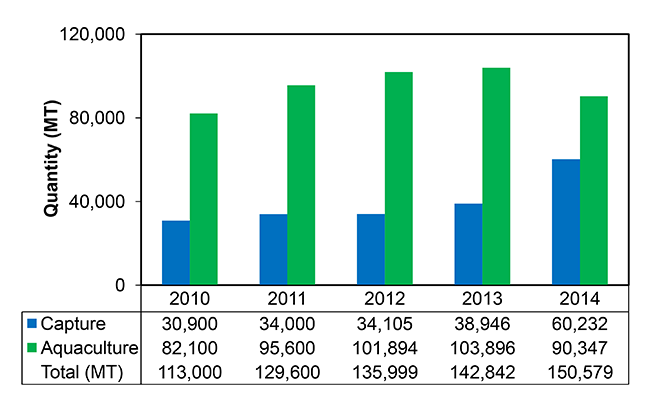 |
Nevertheless, the system of collecting fisheries catch statistics in Lao PDR has been much disputed. More reliable information on catches and on aquaculture should be collected, especially for OAA catches and productivity in wet season rice fields and small water bodies. A regular monitoring scheme should be established and directed towards more field-based monitoring, which could be improved if the system also considers the importance of secondary sources of fisheries information as well as the factors that influence the biodiversity and environment in various types of habitats.
Capture Fisheries
The total area of water resources for capture fisheries in Lao PDR is more than 1.2 million ha. The country’s estimated average consumption of inland fish is approximately 167,922 MT per year while consumption of OAAs is estimated at 40,581 MT per year. Since most of the fish consumed comes from domestic production (imports are negligible and of minor importance), these figures could represent the approximate annual catch or yield from the country’s capture fisheries. The estimated annual yield is conservatively valued at almost US$ 150 million per year.
Capture fisheries in Lao PDR can be categorized by the use of various water bodies such as the Mekong River and its tributaries, large hydropower reservoirs, natural ponds, lakes and small wetland, irrigation reservoirs, weirs, and the large areas of wet season rice fields and seasonal Mekong flood plains. The majority of the catches of the fish and OAAs in the various water bodies are generated by household subsistence and semi-subsistence fishing or artisanal fisheries except from large reservoirs where the fisheries have been organized and normalized. As noted by Coates (2003), the general accessibility of aquatic resources to most local communities, and their high participation in exploitation and utilization of these resources are intimately linked. Fish catch is an integral part of the livelihood of entire communities, where most fishing effort is part time and seasonal in nature. The major fishing gears used in Lao PDR are shown in Figure 3.
| Figure 3. Major fishing gears in Lao PDR |
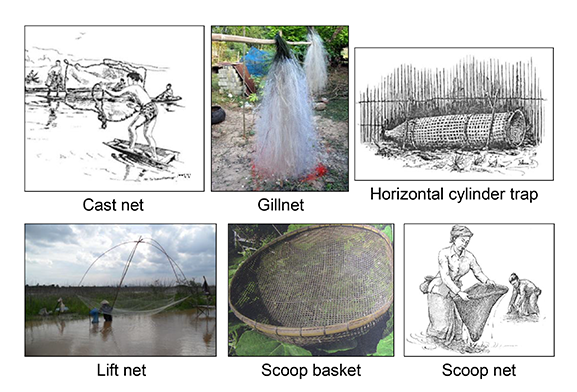 |
Aquaculture
As aquaculture in Lao PDR expands, many forms of production systems are being developed, for example pond culture, communal ponds, rice-cum-fish culture, and cage culture. Most fish culture systems in Lao PDR are small-scale. Such forms of production systems are divided into sub-categories depending on the nature and main activity of the producers. The main fish species for culture as preferred by fish farmers, are silver carp (Hypophthalmichthys molitrix), big head carp (Aristichthys nobilis), grass carp (Ctenopharyn godonidella), catla (Catla catla), rohu (Labeo rohita), mrigal (Cirrhinus mrigala), common carp (Cyprinus carpio), silver barb (Barbodes gonionotus, paphone (Cirrhinus microlepis), Clarias macrocephalus, Pangasianodon hypophthalmus, Hemibagrus wyckioides, Hemibagrus spp., Pangasius krempfi, Pangasius larnaudi, Henicorhynchus siamensis, Barbonymus gonionotus, Anabas testudineus and tilapia (Oreochromis niloticus). According to the DLF, aquaculture production in 2014 accounted for 90,350 MT in an area of more than 58,536 ha including cage culture areas.
There had been a significant increase in intensive tilapia production in recent years in Lao PDR, where almost all tilapia cage cultures were in the Mekong River, its tributaries, and in some irrigation reservoirs. The number of cages for tilapia culture is shown in Figure 4.
| Figure 4. Number of tilapia cages in Lao PDR in 2010-2014 Source: DLF, 2014 |
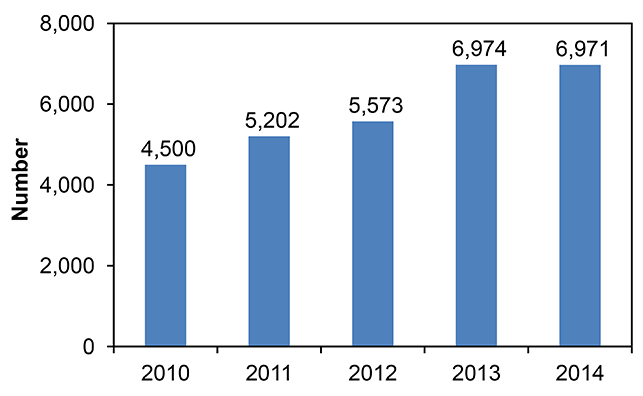 |
Knowing that exotic fish species pose some threats to natural stocks and aquatic biodiversity, the Government of Lao PDR is not in a position to support the introduction of exotic fish species, but the restriction, up to now, has not been effectively enforced. More than 10 exotic fish species have been introduced into Lao PDR through various sources, although mostly not formally recorded. These include Cyprinus carpio (common carp), Carassius auratus (gold fish), Hypophthalmichthys molitrix (silver carp), Ctenopharyngodon idella (grass carp), Hypophthalmichthys nobilis (bighead carp), Oreochromis niloticus (Nile tilapia), Labeo rohita (rohu), Cirrhinus mrigala (mrigal), Catla catla (catla), and Clarias gariepinus (African catfish). Some exotic species, such as the common carp, tilapia, gold fish, and the African catfish have established their own breeding populations in the wild, as well as in ponds and reservoirs. In an attempt to reduce the spread and impact of exotic species, the development of indigenous fish species that would replace or complement the use of exotic species in aquaculture had been highly recommended.
FISHERIES POLICIES AND LEGAL FRAMEWORKS
National Laws
A new Fisheries Law of Lao PDR was endorsed in July 2009, bringing fisheries management within one cohesive framework. It provides a system for implementing, managing, monitoring, and inspecting capture fisheries and aquaculture, and aims to promote aquaculture, conserve and protect fishery resources for sustainable development, and ensure the availability of fish and other aquatic animals for food security. The law also provides for the promotion of community fisheries management and control measures, such as establishment of conservation zones and community pond, and development and enforcement of fishing regulations. In addition, the Law also provides for the protection of aquatic resources and ecosystems through various measures. Nevertheless, implementation of the Law would continue to be a challenge, as it would require education, monitoring and research, as well as support to community-based fisheries management.
Systems for Statistical Data Collection
The statistics system of Lao PDR is decentralized involving several institutions, each with specific assignment. Until 2010, the Department of Statistics (DOS) under the Ministry of Planning and Investment (MPI) was responsible for Population Censuses and Household Surveys in the non-agriculture sector, notably the Lao Expenditure and Consumption Survey (LECS), which is undertaken every five years. The Statistics Law was enacted in June 2010, which upgraded DOS into the Lao Statistics Bureau (LSB), with status equivalent to that of a sub-ministry of a line ministry. The Statistics Law provides LSB the authority to conduct censuses and surveys, compile national accounts and statistics, and provide overall coordination of the system. It also specifies that the line ministries and province, municipality, district and sub-district offices can conduct sample surveys after receiving technical approval from the LSB.
To adopt a decentralized system for collecting agricultural statistics, the DLF in collaboration with the Living Aquatic Resources Research Center (LARReC), Provincial Livestock and Fisheries and District Livestock and Fisheries Units collects and compiles data on livestock and fisheries (capture fisheries and aquaculture) regularly by province, district, and village, and reports the compiled information weekly, monthly, quarterly, biannually, and annually.
REFERENCES
Coates, D. 2003. Biodiversity and Fisheries Management Opportunities in the Mekong River Basin. Mekong River Commission Secretariat. Vientiane, Lao PDR; 40 p
Coates, D., Ouch Poeu, Ubolratana Suntornratana, N. Thanh Tung, and Sinthavong Viravong. 2003. Biodiversity and fisheries in the Lower Mekong Basin. Mekong Development Series No. 2. Mekong River Commission, Phnom Penh, Cambodia; 30 p
DLF. 2014. Department of Livestock and Fisheries, Ministry of Agriculture and Fisheries. Vientiane, Lao PDR
FAOSTAT. 2018. Statistics Division, Food and Agriculture Organization of the United Nations. Available at http://www.fao.org/faostat/en/#country/120. Accessed on 28 May 2018.
Hortle, K.G. 2007. Consumption and the yield of fish and other aquatic animals from the Lower Mekong Basin. MRC Technical Paper No. 16. Mekong River Commission. Vientiane, Lao PDR; 87 p
 SEAFDEC Southeast Asian Fisheries Development Center
SEAFDEC Southeast Asian Fisheries Development Center
